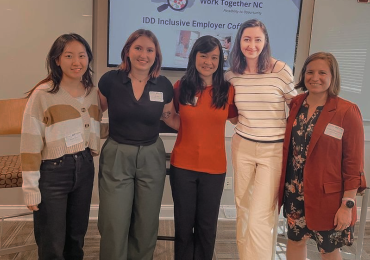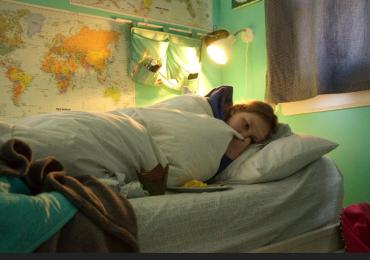The professor took her head in his hands and gently pointed her head in the direction of the letter chart. Her eyes lit up. “Oh, there it is”, and she promptly read the smallest size letters at the bottom of the chart.
Mrs Digby had advanced glaucoma that destroyed her peripheral vision. All that remained was a small tunnel of central vision with crispness that would have made many people envious.
I witnessed this as a final year optometry student on a clinical low vision placement – more than 30 years ago. Its effect left me a memory as fresh as if it had happened yesterday.
It is difficult to appreciate how someone else sees the world. It can be helpful if you can “see through someone else’s eyes”, particularly if you are designing products or environments that will be used by people who have vision impairment.
Here are 4 types of tools that can communicate the impact of vision impairment to people who are normally-sighted.
First-hand accounts
First-hand descriptions can be a powerful tool to help people with normal sight gain insight into vision impairment.
Some accounts are published in the medical peer-reviewed literature. For example, David Cockburn’s confessions of a colour blind optometrist1 gives an entertaining account of how his severe colour vision deficiency affected his service in the Navy during World War II and his career as an optometrist, as well as some practical examples of its effect while sailing, driving, painting, choosing clothes and identifying money. Although congenital colour vision defects, such as Cockburn describes, are not in the same league as more severe vision problems such as glaucoma, a range of acquired colour vision deficiencies do accompany many eye diseases (such as glaucoma, cataracts, age-related macular degeneration). Therefore, Cockburn's descriptions could be helpful for people with normal colour vision who are seeking to understand some of the frustrations of making colour errors.
One of my favourite written accounts is “Picking up Sunshine”, a self-published book by June Stephenson & Elizabeth Mansutti2. In it, Stephenson provides anecdotes of mistakes she has made due to her vision loss from Age-Related Macular Degeneration (AMD), as well as practical tips for maintaining independence. It’s a gem of a book for those who have been diagnosed with AMD and for their relatives and friends who need to understand what kind of help and assistance would be useful.
Digitally enhanced images
A picture paints a thousand words. Digitally altering a photograph or a video is a cost-effective method to illustrate vision impairment. For example, the image on the right-side simulates vision loss associated with cataract: loss of contrast, loss of visual acuity and distorted colour perception:
There are many criticisms of digitally enhanced images. One is that there are many different manifestations of vision loss and that the image may not be a realistic representation of vision loss3.
Another criticism of digitally enhanced images is that it can be difficult to convey the real impact of vision loss, especially if only one portion of the visual field is affected. For example, AMD often causes distortion in the centre of a person’s visual field. This image simulates AMD by distorting the centre of the image and making it difficult to read detail in the sign:
However, a normally-sighted person is not really debilitated because they can scan their eyes over the remainder of the image and read the undistorted portions of the signs.
This video illustrates the impact that distorted central vision has on navigating an environment. NOTE: for best effect, keep your focus trained on the centre of the screen, rather than scanning your eyes to see around the distorted section.
Modified spectacles and goggles
It is possible to modify spectacles and goggles to simulate vision impairment, for example, by painting clear nail varnish over the lens to distort vision, tinting the lens to change colour perception and obscuring the lens to simulate visual field loss. Here is a website that gives instructions for constructing simulation spectacles and goggles, but there are also products available through low vision service and product providers such as Vision Australia, Eschenbach and Optima.
The criticisms of modified spectacles/goggles are akin to those for digitally enhanced images. But with care, they can be constructed so that the wearer cannot “cheat” by looking around the obstruction or filter within the spectacles / goggles. There is also evidence that functional performance of normal-sighted people wearing “blur goggles” can be similar to the performance of people who actually have vision impairment4.
Immersive technology
Immersive technology offers the opportunity to render a high-fidelity simulation of vision impairment. This can be achieved by simulating vision impairment in a virtual scene (virtual reality, VR), or by overlaying a digitally simulated vision impairment on a person’s view of the real world (augmented reality, AR). Here is an example (in Spanish) of an app that can be run from a smartphone attached to a virtual reality headset.
AR and VR simulations are more costly to produce than digital images and modified spectacles/goggles, but a good simulation can enable the wearer to fully immerse themselves in a scene and experience what it may be like to be vision impaired. In their recent publication, Jones and co-authors describe experiments where normally-sighted participants wore AR and VR headsets with simulations of visual field loss similar to that experienced by people with glaucoma5. The participants appeared to experience similar functional limitations to people with glaucoma (for example, they took more time to complete tasks and made additional head and eye movements to search their environment). Some participants also reported emotions that may accompany vision loss, for example, feeling anxious when they were asked to climb stairs.
Conclusion
Not everyone has the privilege I experienced more than 30 years ago when I observed the functional limitations of Mrs Digby’s vision. But it is possible to “see through someone else’s eyes” by reading first hand accounts, looking at digitally enhanced images, wearing modified spectacles/goggles and being immersed in virtual or augmented reality that simulates vision impairment.
These tools can also help designers understand vision impairment, and may lead to the development of more inclusive products and environments for those with vision impairment.
References
- Cockburn, D (2004) Confessions of a colour blind optometrist. Clinical and Experimental Optometry 87: 4-5: 350-352. https://onlinelibrary.wiley.com/doi/10.1111/j.1444-0938.2004.tb05066.x
- Stephenson J, Mansutti E (2007) Picking up Sunshine. Australia. ISBN 978-0-646-47318-5
- Taylor DJ, Edwards LA, Binns AM, Crabb DP (2018) Seeing it differently: self-reported description of vision loss in dry age-related macular degeneration. Ophthalmic and Physiological Optics. 38: 98-105. https://onlinelibrary.wiley.com/doi/full/10.1111/opo.12419
- Legge GE (2014) Prentice Medal Lecture 2013: Visual Accessibility: A challenge for low-vision research. Optometry and Vision Science 91(7): 696-706. https://journals.lww.com/optvissci/Fulltext/2014/07000/Prentice_Medal_Lecture_2013___Visual_Accessibility.3.aspx
- Jones PR, Somoskeoy T, Chow-Wing-Bom H, Crabb DP (2020) Seeing other perspectives: evaluating the use of virtual and augmented reality to simulate vision impairments (openVisSim). npf Digital Medicine (2020) 3:32 https://doi.org/10.1038/s41746-020-0242-6 https://www.nature.com/articles/s41746-020-0242-6
Jennifer Long is a visual ergonomics consultant, based in Sydney, Australia. www.visualergonomics.com.au



